Robert Boles of Cahir, The Builder
His story per family tradition as recounted by his Great-Grandson, Bob Boles of Dublin
Back to The Boles of Cahir
 I would like to express my appreciation to Bob Boles
of Dublin and Cahir for his help in putting this family history
together, to Neil Sharkey for providing us with the basis for our
research and for his feedback and guidance and to Mike Nolan for his
early and thorough spadework which gave us our starting point.
Note: click on the small images on this page to see a
larger picture.
I would like to express my appreciation to Bob Boles
of Dublin and Cahir for his help in putting this family history
together, to Neil Sharkey for providing us with the basis for our
research and for his feedback and guidance and to Mike Nolan for his
early and thorough spadework which gave us our starting point.
Note: click on the small images on this page to see a
larger picture.
St. Mary's Catholic Church, Cahir
See also Robert Boles of Cahir's Family Tree
 Robert
Boles is first on record in Cahir in 1833 as having been a major
contractor in the construction of the St. Mary's Catholic church in
Cahir in which he would be married in 1835.
Family Tradition This was the start of three
generations of builders in Cahir. The church's accounts book
shows that Robert was one of four men who worked on building and
slating the church's tower in May 1842. It's not yet known where he
first lived in Cahir but in 1857 Robert acquired two adjacent
military officer's residences on the central square of Cahir, known
as the Daniels Houses, from Lord Cahir (of the Butler's of Ormonde
family) in payment for some outstanding notes.
In them he
established his building business, a grocery business and possibly
also a pub.
ref.
Full Story In the back lot of the buildings he built a
blacksmith or nail maker's shed, a carpenter's workshop, a mason's
shed etc. He successfully built up his business with contracts
to construct several buildings in Cahir and Clonmel.
Selected newspaper clippings re: Robert's work: (click on any
clipping for a larger copy)
Robert
Boles is first on record in Cahir in 1833 as having been a major
contractor in the construction of the St. Mary's Catholic church in
Cahir in which he would be married in 1835.
Family Tradition This was the start of three
generations of builders in Cahir. The church's accounts book
shows that Robert was one of four men who worked on building and
slating the church's tower in May 1842. It's not yet known where he
first lived in Cahir but in 1857 Robert acquired two adjacent
military officer's residences on the central square of Cahir, known
as the Daniels Houses, from Lord Cahir (of the Butler's of Ormonde
family) in payment for some outstanding notes.
In them he
established his building business, a grocery business and possibly
also a pub.
ref.
Full Story In the back lot of the buildings he built a
blacksmith or nail maker's shed, a carpenter's workshop, a mason's
shed etc. He successfully built up his business with contracts
to construct several buildings in Cahir and Clonmel.
Selected newspaper clippings re: Robert's work: (click on any
clipping for a larger copy)

 One
significant project of his was the rebuilding and restoration of the
City Hall in Cashel. Photos
One
significant project of his was the rebuilding and restoration of the
City Hall in Cashel. Photos
 note:
The original contract for his work was for
£395-10 but additional work was required as the project
proceeded, his invoice for 'sundry work' done in addition to the
work already specified in his contract added up to
£221.
A detailed record of that additional work on the town hall at Cashel was
found in a
manuscript auctioned by Fonsie Mealy Auctioneers in Dublin on July
1, 2014 which was catalogued as 'Item 349 Cost of Cashel Town Hall,
co. Tipperary: manuscript: Admeasurement of Sundry Works executed at
the Town Hall, Cashel by Mr. R. Boles, Builder, April 1867, 5
foolscap m/ss pages, total cost £221-5-10, signed off by the
Architect, J. Rogers, 205 Great Brunswick Street, Dublin'. The
architect's endorsement of the invoice states that this amount was
in addition to the original contract's value.
note:
The original contract for his work was for
£395-10 but additional work was required as the project
proceeded, his invoice for 'sundry work' done in addition to the
work already specified in his contract added up to
£221.
A detailed record of that additional work on the town hall at Cashel was
found in a
manuscript auctioned by Fonsie Mealy Auctioneers in Dublin on July
1, 2014 which was catalogued as 'Item 349 Cost of Cashel Town Hall,
co. Tipperary: manuscript: Admeasurement of Sundry Works executed at
the Town Hall, Cashel by Mr. R. Boles, Builder, April 1867, 5
foolscap m/ss pages, total cost £221-5-10, signed off by the
Architect, J. Rogers, 205 Great Brunswick Street, Dublin'. The
architect's endorsement of the invoice states that this amount was
in addition to the original contract's value.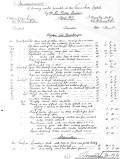
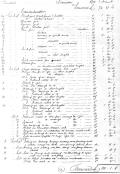
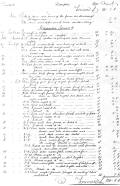
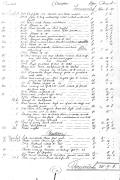
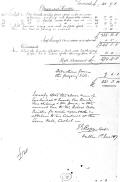 When Robert
died in 1886 he left the back lot and the side of the building
containing his building business to his sons Robert and Neil and the
other side which contained his grocery business to his daughters
Catherine and Eliza.
ref.
When Robert
died in 1886 he left the back lot and the side of the building
containing his building business to his sons Robert and Neil and the
other side which contained his grocery business to his daughters
Catherine and Eliza.
ref.

 In the next generation Robert Jr.'s son Robert, known as Bobby,
took a grocer apprenticeship at the famous Harrod's store in London,
starting as a 'meat boy'
in 1905 but by the time he returned to Cahir in 1908 he had learned
much about operating a grocers shop. At first he worked for a
few years for his Uncle Cornelius Downing and then he opened a
second grocery store in the side of the Boles building beside his
Aunt Kate's. Not as her competitor as he aimed his shop at a
different market. The knowledge that Bobby had gained during
his time at Harrod's gave him the experience to identify and obtain
the products sought after by the Anglo-Irish Gentry of the area.
His shop developed a reputation for excellence specializing in items
for a high end clientele such as pastas, olives, anchovies, salami
etc. as well as Gin, Claret and Port wine and a selection of fine
teas including his own blend Robert F. Boles' Golden Cup Tea.
In the next generation Robert Jr.'s son Robert, known as Bobby,
took a grocer apprenticeship at the famous Harrod's store in London,
starting as a 'meat boy'
in 1905 but by the time he returned to Cahir in 1908 he had learned
much about operating a grocers shop. At first he worked for a
few years for his Uncle Cornelius Downing and then he opened a
second grocery store in the side of the Boles building beside his
Aunt Kate's. Not as her competitor as he aimed his shop at a
different market. The knowledge that Bobby had gained during
his time at Harrod's gave him the experience to identify and obtain
the products sought after by the Anglo-Irish Gentry of the area.
His shop developed a reputation for excellence specializing in items
for a high end clientele such as pastas, olives, anchovies, salami
etc. as well as Gin, Claret and Port wine and a selection of fine
teas including his own blend Robert F. Boles' Golden Cup Tea.In the 1930's Bobby Boles acquired his Aunt's side as well and the two stores were joined into one and traded as R. F. Boles Grocer and Seedsman. The buildings on The Square are also still in the Boles family today. They are joined together with a central corridor which is now the entrance way to a shop which extends across the front of the two buildings so that they appear as one building from the street. Full Story
R.F. Boles Grocer on Cahir Square in 1965
A photograph of Cahir Square taken in about the 1940's by Father Browne the photographer who was famous for having sailed on the Titanic from Belfast to Southampton to Cobh, county Cork and then disembarking before its fateful departure with the only surviving photographs of passenger life on the ship. The arrow on the Car Park sign is pointing directly at the Boles shop. Killeigh Lodge, originally called
Balgownie,built for Bobby Boles by his Uncle Neil Boles as an exact
copy of Gortmalogue House in Clonmel. The Boles family still
lives there today.
Killeigh Lodge, originally called
Balgownie,built for Bobby Boles by his Uncle Neil Boles as an exact
copy of Gortmalogue House in Clonmel. The Boles family still
lives there today.